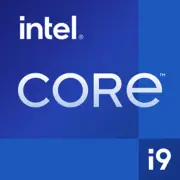Intel Core i9-9880H

Intel Core i9-9880H in 2025: Is it worth getting a laptop with this processor?
Analysis of capabilities, comparison with competitors, and selection tips
Architecture and Technology Process: The Legacy of Coffee Lake
The Intel Core i9-9880H processor, released in 2019, is based on the Coffee Lake-H architecture and a 14nm technology process. Although by 2025 this technology process is considered outdated (compared to the 5nm Apple M3 and 4nm AMD Ryzen 8000), it remains a testament to Intel's reliable engineering of its time.
Key Features:
- 8 cores and 16 threads — a strong foundation for multitasking and heavy computing.
- Base clock: 2.3 GHz, maximum Turbo Boost frequency of up to 4.8 GHz (for a single core).
- 16 MB L3 cache — speeds up data processing in resource-intensive applications.
- Integrated graphics UHD 630 — with 24 EU (Execution Units), supporting 4K@60 Hz. Suitable for basic tasks, but not for modern gaming.
Architecture Features:
- Support for DDR4-2666 MHz (up to 128 GB) and PCIe 3.0 (16 lanes).
- Hyper-Threading and Thermal Velocity Boost technologies for automatic frequency boosts with cooling.
Power Consumption and TDP: Balancing Power and Heat
The processor's TDP is rated at 45 W, but in reality, consumption can reach 90-100 W in Turbo mode. This necessitates an effective cooling system, which complicates usage in thin ultrabooks.
What does this mean for the user?
- Laptops with the i9-9880H typically have large coolers and weigh at least 2.5 kg.
- Without quality cooling, the processor throttles (reduces frequencies), leading to a significant drop in performance.
Performance in 2025: Where is it still relevant?
Geekbench 6 benchmark results (1355 / 6052) show that the i9-9880H remains competitive in multithreaded tasks but lags behind in energy efficiency.
Office Tasks and Multimedia:
- Easily handles dozens of browser tabs, streaming video, and office suites.
- 4K editing in Premiere Pro or DaVinci Resolve is possible, but rendering will be slower than on newer Ryzen 7 7840U CPUs (+20% speed improvement).
Gaming:
- Integrated graphics UHD 630 — the weak point: only older games can run at low settings (e.g., CS:GO — 40-50 FPS at Full HD).
- With a discrete GPU like the NVIDIA RTX 3060 or higher — comfortable FPS in games from 2023-2024 (Cyberpunk 2077 — 60 FPS on medium settings).
Turbo Boost Mode:
- Peak frequency lasts 10-15 seconds before stabilizing at 3.8-4.2 GHz (depends on cooling).
Usage Scenarios: Who is the i9-9880H Suitable for in 2025?
1. Professionals on a budget:
- Video editing, 3D modeling, programming. Example: Dell Precision 7540 (price in 2025 — from $800).
2. Gamers looking for used hardware:
- Devices with RTX 2070/3060 and i9-9880H can be found for $700-$900.
3. Universal users:
- Streaming work, virtualization.
Battery Life: The Processor's Weak Point
With a TDP of 45 W, battery life for laptops rarely exceeds 4-5 hours (web browsing, office). Under load (gaming, rendering) — about 1.5 hours.
Energy-Saving Technologies:
- Intel Speed Shift — dynamic frequency management.
- Adaptix Thermal Framework — optimization of fan performance.
Tips:
- Lower the screen brightness.
- Disable Turbo Boost in the power settings.
Comparison with Competitors: Who is Better?
1. AMD Ryzen 9 5900HX (2021):
- Pros: 7nm technology, better energy efficiency (+15% battery life).
- Cons: lower frequency in single-threaded tasks.
2. Apple M2 (2022):
- Pros: 18-hour battery life, cool operation.
- Cons: macOS, limited compatibility with Windows software.
3. Intel Core i7-12800H (2022):
- Pros: 10nm process, +25% IPC improvement.
- Cons: more expensive on the secondary market.
Pros and Cons of the i9-9880H in 2025
Strengths:
- High multithreaded performance.
- Affordable price on the used market ($500-800 for a laptop).
- Support for Windows 11 and Linux.
Weaknesses:
- High heat output and noisy cooling.
- Outdated PCIe 3.0 and DDR4.
- Low battery life.
Recommendations for Choosing a Laptop
1. Device Type:
- Gaming laptop (ASUS ROG Strix, MSI GP75) — for gaming with discrete GPU.
- Workstation (HP ZBook 15) — for professional tasks.
2. What to Look for:
- Cooling system: at least two fans and heat pipes.
- Battery: from 80 Wh.
- Display: IPS matrix with 100% sRGB for color work.
Final Conclusion: Who Should Consider the Core i9-9880H?
This processor is worth considering in 2025 if:
- You need a powerful laptop for work or gaming under $800.
- Battery life and weight are not critical concerns.
- You have the option to upgrade (SSD replacement, RAM addition).
Key Benefits:
- Budget savings without significant performance compromises.
- Proven reliability of the Coffee Lake platform.
However, if you want a modern laptop with long battery life, consider models with the Ryzen 7 7840U or Apple M3.
Basic
CPU Specifications
Memory Specifications
GPU Specifications
Miscellaneous
Benchmarks
Compared to Other CPU
Share in social media
Or Link To Us
<a href="https://cputronic.com/cpu/intel-core-i9-9880h" target="_blank">Intel Core i9-9880H</a>